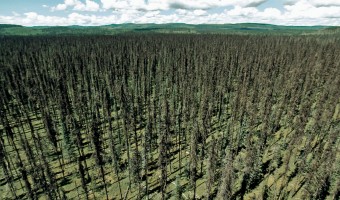
Lesson Summary
Students will use the stories in episode two to better understand the long term impacts deforestation and longer wildfire seasons have on the environment.
Learning Objectives
- Students will examine evidence and sources of evidence to draw conclusions and make predictions.
- Students will analyze climate maps, including positive and negative trends, correlations, and make predictions based on evidence and patterns over time.
- Students will recognize the connection between climate change and the increase in quantity and severity of wildland fires and be able to support this understanding with scientific fact.
Teacher Background
A little science from Smokey the Bear
The word “fire” refers to the natural phenomenon that occurs whenever a combustible fuel comes into contact with oxygen at an extremely high temperature. Fire is the byproduct of a chemical reaction in which a combustible fuel is converted to a gas. A fire’s flame refers to the visual indication of light that occurs once the gas is heated, and is evidence that a fire has taken place.
From this perspective there are many ways we can use fire to teach scientific concepts to students, e.g. chemical reactions, combustion, forms of energy, etc., but for this lesson we want to focus on how climate change is affecting the length and intensity of our nation’s fire season and on the impact wildland fires have on the environment, the economy and the community.
From January 4, 2014 to April 10, 2014 there has been approximately 114, 143 acres burned in the U.S. Fire season officially begins, April 15th and with states such as California, New Mexico, and Texas in the death grips of an “extreme to exceptional” drought and almost every state east of the Mississippi suffering at various levels of drought severity, it’s time to take a look at the connection between climate change and the fires that wreak havoc on our nation’s communities and wildscapes. Utilize this lesson along with the stories in episode two to help you facilitate a meaningful learning experience for your students.
Lesson Videos
Lessons
Stories MS-2: Fire Line & Last Stand
In “Fire Line,” Arnold Schwarzenegger joins an elite team of wildland firefighters as they battle a new breed of forest fire, one made more deadly by climate change. In “Last Stand,” Harrison Ford travels to Indonesia to investigate palm oil and deforestation.
Materials MS-2

For this lesson each student will need a Science Notebook. You will need Internet access for every student or pair of students so they can read the articles and analyze the data.
Vocabulary MS-2

Anecdotal evidence, burn scar, carbon cycle, carbon sinks, climate, climate change, correlation, corruption, credible, deforestation, distribution, drought, equal and just, evidence, deforestation, emissions, fact, greenhouse gases, Green Peace, interconnectedness, impact, local v. global, natural cycle, opinion, peat, qualitative data, quantitative data, religion, scarcity, science, sequester, trend line, want versus need, weather
Prerequisite Knowledge MS-2

Before beginning, assess your students’ prior knowledge around events and issues presented in the lesson. Have students take the Pre-Quiz. This will allow you to see the knowledge your students have prior to watching episode 2.
Engage MS-2

Have students watch the beginning of the Black Forest Fire as reported by the citizen who called 911 and then answer questions about what they have seen in their Science Notebooks .
Explore MS-2
Length: 45 minutes

Watch Episode Two. If you are unable to view Episode Two in its entirety then students will need to watch the following segments to support their learning experience.
Explain MS-2
Length: 55 minutes

There are three components that affect wildfires, temperature, wind, and moisture. In this activity, students work on correlating data about temperature, precipitation, and drought with incidents of wildfire.
Elaborate MS-2
Length: 20 minutes

You will provide students with a statement about wildfires to which they will either agree or disagree. Assign a side of the room that will represent “agree” and a side of the room that will represent “disagree”. Explain there is no middle ground, thus the title – Take a Stand.
Evaluate MS-2
Length: 15 minutes

The interactive online quiz provides instant feedback about your knowledge of this subject. The justified true/false questions are meant for use in the classrooms.
Taking Actions and Designing Solutions MS-2

Taking actions and/or designing solutions to our local, national, and global problems are a personal journey. Via Facebook /yearsofliving and Twitter @yearsofliving #YEARSproject, share how you are taking action to combat climate change or if you’ve designed potential solutions share those on Instagram – yearsofliving or make a Vine.
Writer’s Corner MS-2

Without language there is no science. To be practicing scientists and derive new knowledge, we need language – reading, writing, talking, listening, enacting, and visualizing. Writing is one way to communicate understanding of our learning while allowing us to be creative in our delivery and provide insight and possible solutions to problems.
Agents of Change MS-2

Michael Mann, PhD, is Director of the Penn State Earth System Science Center and a member of the Penn State University Faculty, holding joint positions in the Departments of Meteorology and Geosciences, and Earth and Environmental Systems Institute.
Careers MS-2

Inspired by Episode 2? Thinking about your future? You have the power to make a difference today and in the future. Look into careers inspired by the issues presented in Episode 2: End of the Woods.
Resources and Links MS-2

Use the following print and online resources to supplement your understanding of the material covered in this lesson.
Standards MS-2

Download the standards tables for Middle School Lesson 2: 21st-Century Skills and NGSS, CCSS, and NCSS.
PDF Lesson Plan MS-2

Download a printable PDF lesson plan for Middle School Lesson 1, including justified true-false form and formatted standards tables.

